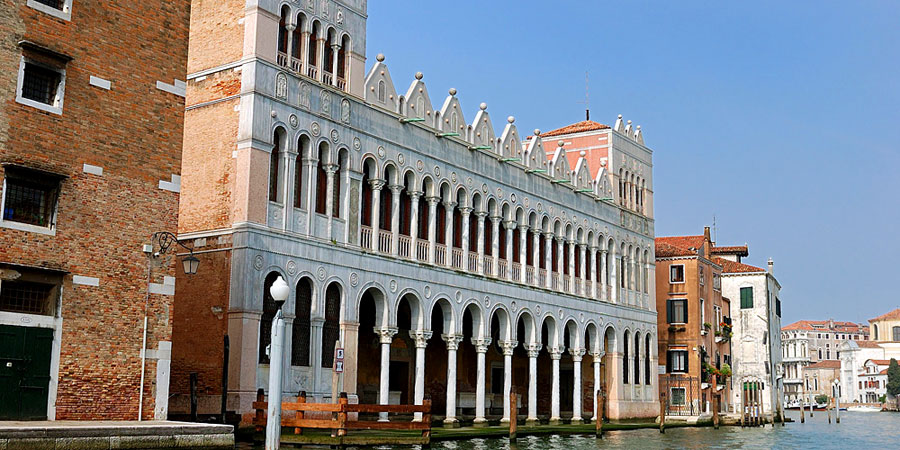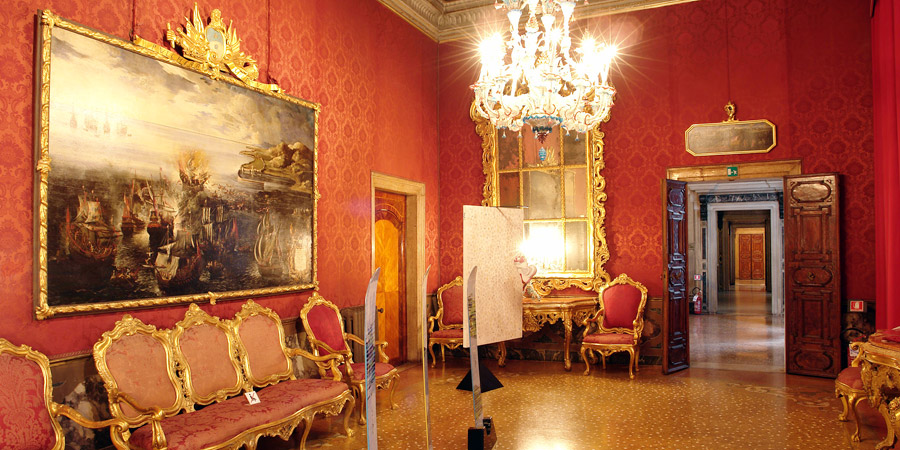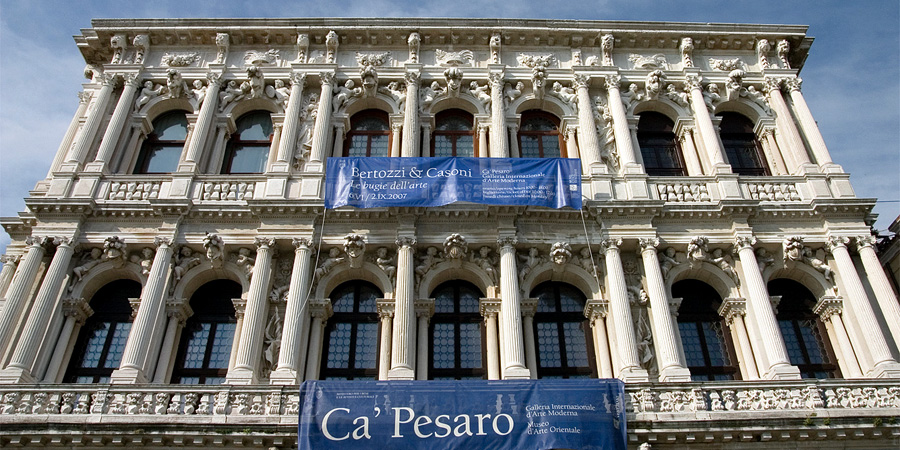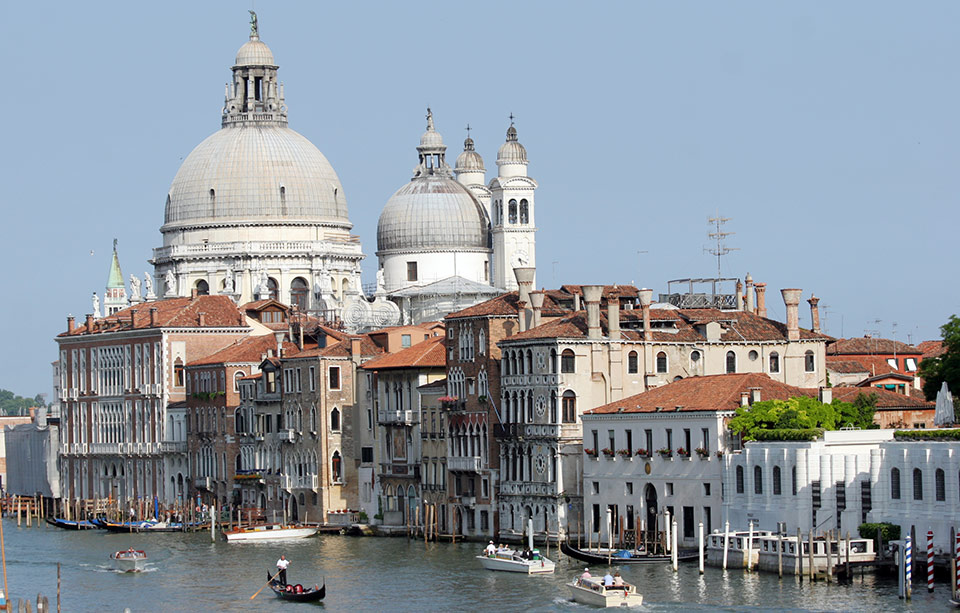The sestiere of Santa Croce is the north-east of the city and via Piazzale Roma it connects Venice to the mainland. All this area has been subject to many demolitions and transformations, starting in 1810 with the demolition of the church and monastery of of Santa Croce, which gave their name to the district.
The Papadopoli gardens were laid out in the area. The gardens were designed by Bagnara in the likeness of English gardens. they are now open to the public but have been completely changed.
Church of San Nicola da Tolentino

The Chiesa di San Nicola da Tolentino or San Simeone Grande was designed by Vincenzo Scamozzi, finished by the Teatini monks, and consecrated in 1602. The main altar was created by Baldassare Longhena in 1661 and has sculptures by Justo Le Court. The facade was designed by Andrea Tirali in 1714.
The interior of the church is decorated with paintings of the seventeenth century. There are works by Jacopo Palma il Giovane and Padovanino. Six doges are buried here. The church houses the magnificent Baroque organ built in 1754 by Pietro Nachini. This church was hit during the bombing of 1849 Austrians: a cannon ball, falling in front of the main altar breaking through the dome (now removed), it is now embedded in the facade, in memory of the episode.
Church of San Simeone Profeta

The Chiesa di San Simeone Profeta was founded in 967 as a basilica with three naves and retains this layout today despite two renovations in the eighteenth century by Domenico Margutti and Giorgio Massari. The facade is the mid-nineteenth century. The present building is flanked on the left by a portico (Sotoportego).
Inside, to the right of the entrance, is located The Presentation in the Temple by Jacopo Palma il Giovane. In the second altar in the left aisle is placed a painting by Jacopo Tintoretto depicting The Last Supper.
Church of San Simeon Piccolo

The Chiesa di San Simeon Piccolo, on the Grand Canal, to the right of Adoldo Palace and opposite the Venice train station, was built in the eighteenth century with a central layout and an impressive cupola. It predates the classical style. The church was founded in the ninth century by families Adoldi and Briosi.
It is one of the most famous churches in the city, at least as regards its external appearance, it represents one of the first neoclassical buildings in Italy. Under the church there is an interesting crypt frescoed with scenes of the Cross and the Old Testament, in which two long corridors crossing in an octagonal room, which has an altar in the middle.
Square and Church of San Zan Degolà

The Chiesa di San Zan Degolà is dedicated to San Giovanni Decollato, which has become San Zuane Degolà in Venetian dialect. The church is very old. It was originally an oratory and then became a parish church in 1007. Despite the alterations in the eighteenth century it still maintains the appearance of a Venetian-Byzantine church.
The interior is very simple, with three naves are divided from each other by two rows of four precious marble greek columns with Byzantine capitals (XI century). Of great value are also the remains of frescoes, recently discovered, depicting the heads of four saints (John, Peter, Thomas and Mark) and St. Helen Empress carrying the Cross on a background of architecture.
Fondaco dei Turchi

The Fondaco dei Turchi was originally built as a private residence by the Pesaro family in the thirteenth century. It was then bought in 1381 by the Venetian Republic, who donated it to Nicola d'Este. In 1621 the Venetian Republic rented it from the Pesaro family, who had reacquired the building and then handed it over to Turkish merchants who used it as a residence and for storing their merchamdise.
In 1858 it was bought by the city of Venice, which radically restored it. Today it is the seat of the Natural History Museum. Following restoration of the entire building complex, completed in 2011, the museum has been renovated and opened to the public with 16 new rooms, a new garden and a new entrance area. On the ground floor has been prepared the new gallery of cetaceans.
Church of San Giacomo dall'Orio

The name may well derive from the laurel that formerly grew around the Chiesa di San Giacomo dall'Orio, but it is more likely to refer to the 'luprio' or empty marshland, from which the name Orio may derive. Founded in the 9th century, the church San Giacomo dall'Orio is one of the oldest churches in Venice.
Its present form, a Latin Cross with a central nave, two aisles and a transept, is the result of a rebuilding project initiated in 1225 and of subsequent modifications carried out in the 15th and 16th century and there are still traces of the Byzantine building from 1225. The wooden Gothic ceiling is like the hull of a ship. Inside the church you can see a number of masterpieces of Venetian painting.
Mocenigo Palace at San Stae

The Palazzo Mocenigo is an ancient patrician residence and was donated to the city of Venice in 1954. It still contains old seventeenth century furnishings and today it houses a museum of textiles and clothing. The tour begins through the rooms on the first floor and offers a wide selection of the most important items of clothing from the collections.
The clothes and accessories on display, mostly of Venetian origin, are made of textured fabrics, often decorated with embroidery and lace. It also boasts a rich specialist library.
Church of San Stae

The Chiesa di San Stae (San Eustachio) was rebuilt in the seventeenth century on pre-existing Byzantine structures and consists only of a central nave. It is the work of Giovanni Grassi. The altars have works by eighteenth-century artists such as Piazzetta and Tiepolo. The single nave is flanked on each side by three open chapels.
Half-way down the church the paving is occupied by a large tombstone that marks the burial place of the Mocenigo family. The façade was designed by Domenico Rossi with sculptures by early eighteenth-century artists such as Tarsia and Corradini.
Ca' Pesaro

The Ca' Pesaro was built by the Pesaro family in 1628 by renovating and joining together existing buildings. The architect was Baldassarre Longhena. The building was given a sumptuous façade overlooking the Grand Canal in 1679. After Longhena died, the work was finished by Antonio Gaspari.
A typical example of Venetian Baroque, today it houses the Museum of Modern Art. It contains major nineteenth and twentieth century works. The second floor houses a collection of Oriental Art that once belonged to Enrico Bourbon-Parma.
Church of Santa Maria Mater Domini

The Chiesa di Santa Maria Mater Domini was already a parish church in the eleventh century, according to the chronicles, was built by the families Zane and Cappello in 960 and assigned to the adjacent monastery of Santa Cristina. It was renovated in the sixteenth century, and is still laid out in the form of a Greek cross.
The façade is in Tuscan Renaissance style. Inside, there are works by Lorenzo Bregno and paintings by Catena and Tintoretto. The bell tower was rebuilt in 1743: the previous collapsed three years ago.
Corner della Regina Palace (Prada)

Ca' Corner della Regina was built in the eighteenth century to a design by Domenico Rossi. It was built on the site of property that already belonged to the Corner family. Caterina Corner was born there in 1454. In 1471 she became queen of Cyprus through marriage and the palazzo thus became known as 'della Regina'.
It is a modulated building on three levels, but particularly slender due to the presence of two mezzanines, in the attic and between the ground floor and first floor. Today, it houses the Fondazione Prada, and hosts contemporary art exhibitions and cultural activities of the Fondazione Prada.




